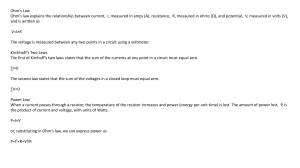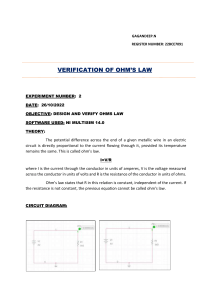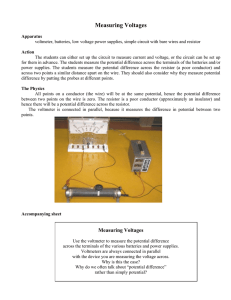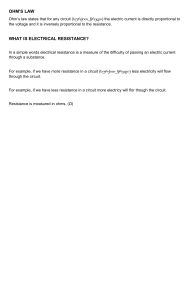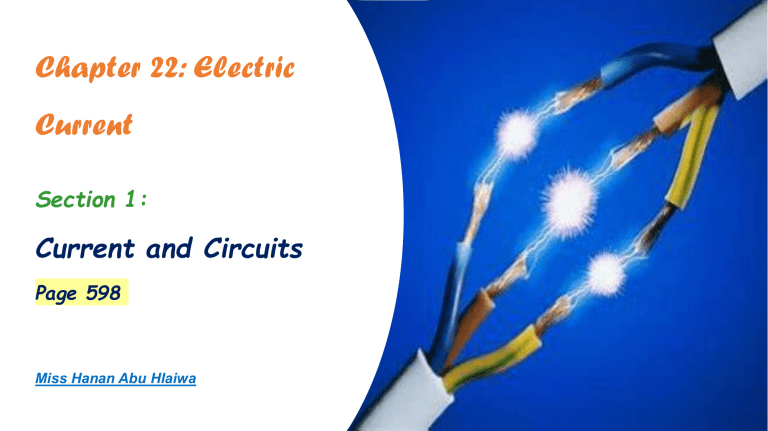
Chapter 22: Electric Current Section 1: Current and Circuits Page 598 Miss Hanan Abu Hlaiwa Essential Questions 1) What is electric current? 2) How does energy change in electric circuits? 3) What is Ohm’s law? 4) How are power, current, potential difference, and resistance mathematically related? Vocabulary electric current conventional current resistance resistor battery electric circuit parallel connection ampere series connection Objectives • To define electric current. • To distinguish between conventional and electron current. • To calculate the electric current using the formula. • To define resistance. • To describe the relation between V and I using ohm’s law. • To apply the mathematical formula of ohm’s law in solving problems. • To list the factors that affecting resistance. • To define electrical power and derive the relation between P, I and V. Potential Difference And Flow of charges Without potential difference the charges cannot flow. • Battery creates an electric potential difference that allow the flowing of charges through the circuit. • By convention positive charges flow from the position of higher potential to the position of lower potential. ( from +ve to –ve) • In reality the electrons flow from –ve to +ve. • flow of charged particles creates electric current. Energy Transformation • Electric charges leave the battery with high electric energy, they transfer this energy to the device (lamp, motor, …). • The Electric potential energy lost by the charges is converted into other form of energy (light, heat, kinetic…) • Electric charges return to battery with low electric energy. • Battery pump the charged particles from the lower potential back to the higher potential (increases the electric potential energy) to maintain the electric potential difference in the circuit. Electric Current Electric Current is the rate of flow of electric charges. Or the quantity of charge Q passes each second. Current = 𝐶ℎ𝑎𝑟𝑔𝑒 𝑇𝑖𝑚𝑒 𝒒 𝐈= 𝒕 Where; • q is the charge (Coulomb) • t is the time (seconds) • I is the current intensity (C/s) which is equivalent to Ampere (A) Recall, we can use the following equation to find the charge, q=Ne. Direction of Electric Current Conventional current is the direction in which a positive test charge moves (from +ve terminal to –ve terminal) Electron current is the direction of the flow of negative charges (electrons). (from -ve terminal to +ve terminal) Practice 1) 20 C charge passing through a cross section of a conductor every 4 seconds. Find the current intensity. 𝑞 𝑡 I= = 20 4 =5𝐴 2) How many coulomb pass at 1 min if the current is 10 A. I= 𝑞 𝑡 10 = 𝑞 60 q = 600 C Practice 3) 1020 electrons pass through a cross section of a conductor every 10 seconds. Find the current intensity. I= 𝑞 𝑡 I= 𝑁𝑒 𝑡 = 1020 𝑥1.6𝑥10−19 10 = 1.6 𝐴 4) How many electrons pass through 5 seconds if the current intensity is 20 A I= 𝑞 𝑡 20 = I= 𝑁𝑥𝑒 𝑡 N = 6.25 x 1020 electron 𝑁𝑥1.6𝑥10−19 5 Electric Circuit Any closed loop or conducting path allowing electric charges to flow is called an electric circuit. Electric circuit can be represented using simple symbols. _ Circuit Schematic + Circuit Construction Kit: DC (colorado.edu) Most Common Circuit Symbols Parallel and Series Connections • A connection with only one current path is called a series connection. • Anytime the current has two or more paths to follow, the connection is a parallel connection. Instruments Used To Measure Voltage And Current • Voltmeter is a device used to measure electric potential difference. It is connected in parallel. • Ammeter is a device used to measure current. It is connected in series. • Often these devices are combined in a single device called multimeter. Voltmeter And Ammeter Connection Voltmeter Ammeter is connected within the circuit (in series) Voltmeter is connected outside the circuit (in parallel) Practice b) Add voltmeter to measure the voltage across the resistor. Practice Resistance And Ohm’s Law Resistance: the opposition of flow of current. it measures how strongly a material can impedes (opposes) the current. Ohm’s law states that the current flowing through a conductor is directly proportional to the voltage across it. 𝐕 = 𝐈𝐑 We can use ohm’s law equation to find the resistance of the conductor (R) using the equation. Resistance 𝐑= 𝚫𝐕 𝚰 Where; • ∆V is the potential difference (Volt) • I is the current (A) • R is the resistance of the conductor, SI unit is (V/A) which is called (Ohms Ω) Ohm's Law simulation Ohm’s Law Mathematical Formula Resistors Resistor is a device designed to have a specific resistance. Fixed resistor whose resistance is constant. Variable resistor whose resistance can be changed to different values. • Examples of variable resistors, like potentiometer, rheostat,… • You can change the resistance using a knob or slider. Quick We can control the current in aCheck circuit by: Varying Voltage Varying Resistance Varying both V and R. 𝐕 𝐈= 𝐑 Questions: 1) 2) 3) 4) 5) 6) 7) a) b) Current will double. If the voltage is doubled, what will happen to the current? If the voltage is halved, what will happen to the current? Current will be halved. If the resistance is doubled, what will happen to the current? Current will be halved. If the resistance is halved, what will happen to the current? Current will double. If the voltage is doubled and resistance is doubled, what will happen to the current? Current will stay the same. If the voltage is doubled and resistance is halved, what will happen to the current? Current will quadrable Choose the correct answer. Current and voltage are (directly proportional, or inversely proportional) at constant R. Current and resistance are (directly proportional, or inversely proportional ) At constant voltage. Practice Problems Page 607 13) 14) 15) Factors Affecting The Resistance 1) 2) 3) 4) Length of a Conductor Cross-sectional area of a Conductor. Temperature of a conductor. Nature of material of a conductor. Quick Check 1) The resistance of the conductor is 2) The resistance of the conductor is _________________ to its length. _________________ to its crosssectional area. A. Directly proportional B. Inversely proportional C.Independent A. Directly proportional B. Inversely proportional C.Independent Power power is the amount of energy transferred or converted per unit time. • or it is the rate at which energy is transferred or transformed. Power 𝑬 𝑷= 𝒕 Where; E is the energy transferred; SI unit is Joules (J). t is the time taken; SI unit is second (s). P is the power; SI unit is (J/s) which is called watt (W). Electrical Power • The energy carried by an electric current depends on the charge transferred and the potential difference across which it moves. 𝐸 = 𝑞 ∆𝑉 => 𝑃 = 𝐸 𝑡 = 𝑞 I= 𝑡 and 𝑞 ∆𝑉 𝑡 = 𝐼 𝑡 ∆𝑉 𝑡 Electrical Power => 𝑞 = 𝐼 × 𝑡 = 𝐼 ∆𝑉 𝑷 = 𝑰 ∆𝑽 Practice Problems Page 601 Answers 1) 5) 2) 6) 3) 7) 4) Practice Problems Page 607 16) 17) Another Formulas For Power Electrical Power Using Ohm’s Law ∆𝑽 = 𝑰𝑹 ⇒ ∆𝑽 𝐔𝐬𝐢𝐧𝐠 𝐈 = ⇒ 𝑹 𝑷 = 𝑰 ∆𝑽 𝑷 = 𝑰𝟐 𝑹 ∆𝑽 𝑷= 𝑹 𝟐 Section Review page 608 19) 20) Section Review page 608 21) 22) 24)
